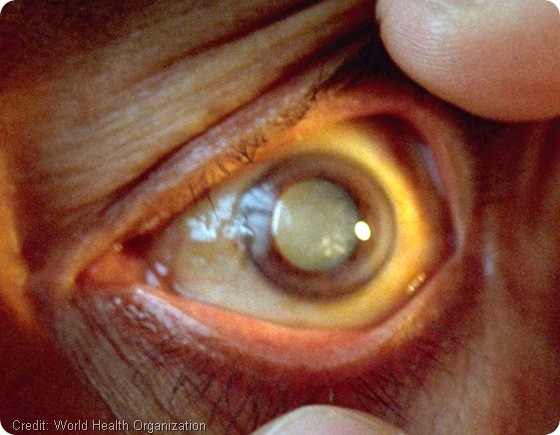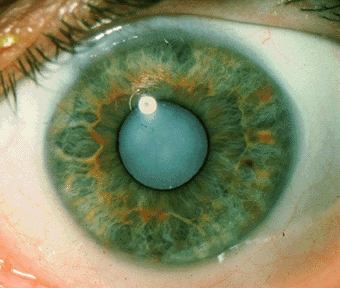What are Cataracts?

A cataract, a common eye condition among the elderly, is a clouding of the lens that can greatly affect the clarity of your vision. The lens is the portion of your eye that aids in focusing light onto your retina.
In a healthy lens, the color will be clear and transparent. However, in an eye with cataracts, the lens will be a milky white color.
The cloudiness of the lens hinders its ability to send light to the retina (the part of the eye that sends images to the brain). This creates an image that is blurred rather than being sharp as in a healthy eye.
While cataracts can develop in both eyes, they are not spread from eye to eye. Each cataract forms independently in the eye in which it develops. By age 75, approximately 70% of Americans have cataracts or have previously undergone cataract removal surgery.
Cataracts? Get Remedies Fast!
Causes of Cataracts
The majority of cataracts are simply a product of the aging process however there are other causes. A secondary cataract is one that is caused by problems from a previous eye surgery for other problems such as glaucoma. A traumatic cataract is one that develops from an eye injury. These may not develop until years after the injury has occurred.
If you receive an injury to the eye, it is important to continually receive eye exams in order to detect the problem at an early stage. Another form of cataracts is a form known as congenital cataracts. This is a condition in which a baby is born with or develops cataracts in early childhood. In this condition, both eyes are usually affected.
However, in most cases the cataracts are so small that do not affect the child’s vision. If vision is impaired, the lens will have to be removed to correct the problem. Finally, there are also radiation cataracts. Radiation can affect many different part of the body including your eyes. Upon exposure to certain radiation, cataracts may soon develop.
Risk Factors of Cataracts
Because the majority of cataracts develop due to age, everyone is at risk for this problem. While age is the leading cause, there are other factors that also increase your chances for developing cataracts. Diabetes is one factor that puts you at a higher risk. If you have or develop diabetes it is important to monitor your blood sugars continuously.
By managing the disease and maintaining proper glucose numbers, you can decrease the chances of development. Also, cataracts have been shown to run in the family. If your family has a history of cataracts, then you should take all of the preventative measures possible to lower your risk. If you have had any previous eye surgeries or eye injuries you are also at a higher risk.
Damage to the eye can cause a cascade of events that lead to cataracts. Cataracts are also associated with steroid use. In particular, corticosteroids seem to increase the chances of cataracts. However, it is prolonged use of these drugs that put you at high risk, not simply using them for proper treatment. Over exposure to UV light (sunlight) and ionizing radiation (x-rays, gamma rays, or electron beams) also puts you at a higher risk.
Decreasing exposure or wearing protective pieces such as sunglasses or sunscreen can help to lower the risk. Finally, smoking also increases the risk of cataract development. If you fall into any of these categories, you should talk to your doctor about preventative measures as well as learn information about the disease.
Signs and Symptoms of Cataracts
While there are many causes of cataracts, each variation generally has the same signs and symptoms. The cataract usually develops slowly causing no pain. In the beginning stages, you may not even notice any vision impairment because the area clouded is so small.
As the disease progresses, more of the lens will become clouded and you will begin to notice blurred images or even image distortions. In addition to blurred or distorted vision, there are several other signs and symptoms that are characteristic of this disease.
The following are all common signs and symptoms of cataracts
Decreased Night Vision
Vision in night light or dark rooms may become more difficult. Because the lens is not transferring light as effectively, small amounts of light make seeing even more difficult. In these conditions you may find yourself straining your eyes in order to see properly. Because of this, you may also find yourself needing to increase the amount of light you need for reading and other related activities.
Sensitivity to bright lights and glare- One trademark symptom of cataracts is seeing halos around lights such as head lights and street lamps. This symptom goes hand in hand with the blurred vision. Because of the impaired lens, light is not transmitted as effectively causing un-even distribution.
Color Fade
You may notice that colors seem faded and in some cases take on a yellowish tint. This is also due to the cloudiness of the lens. Because the lens is no longer clear, colors will not appear as sharply. Also, in some cases, the clouding will progress to a level that gives items a yellow tint.
Double Vision
It is very common to begin seeing double in one eye. As with all of the other symptoms, the defect on the lens is the source of this problem as well.
Contrary to common believe, the cataract will not change your eye’s appearance. The only time that you will see a change is if the cataract becomes completely white.
This is a condition known as an overripe cataract. Aside from that condition, redness, itching, or irritation are not associated with cataracts but may indicate another type of eye infection. The only effective way for determining if you have a cataract is to get the proper testing done by a trained professional.
Tests and Diagnosis for Cataracts
There are many tests that can be performed during a typical eye exam to determine for cataracts. The first is called the Visual Acuity Test. This is the typical test that you receive on all eye exams. You simply read the letters across the room one eye at a time.
What they are testing for is the sharpness of vision. In a cataracts patient, the largest letters on the test may pear blurry even with the help of corrective lenses. Next, you will need to get a Slit-lamp examination. With a specialized tool that projects a small line of light, the doctor can examine the small structures of the eye such as the lens.

With this test, the doctor will be able to see any abnormalities of the lens such as clouding. In addition to the Slit-lamp exam, the doctor will also perform a retinal examination.
By using dilating drops, the pupil will widen and allow for a better viewing area of the internal structures.
By combining the Slit-lamp and retinal exam, they will be able to determine both if you have cataracts as well as how severe they are. All of these exams are ones that are performed at your typical eye exam making diagnosis of this problem much simpler and less costly that that of other diseases.
Prevention Techniques for Cataracts
There are a few preventative measures you can take to decrease your chances of getting cataracts.
The following list includes some of these measures
Eye Exams
it is very important to receive yearly eye exams so that any abnormalities or problems can be detected in the early stages. By knowing about the problem early on, you can take other preventative measures to prolong the progression of development.
Smoking
Smoking increases the chances of development of cataracts. Smoking produces free radicals within your body that cause damage to many structures. What free radicals do is disrupt the cells of your body turning your normal cells into free radicals as well. Your body will no longer recognize the distorted cells and begin to try to destroy them. In the process of destroying these damaged cells, the structure around them can also be damaged as well.
Diet
While not proven effectively, it is suggested that increasing the amount of vegetables and fruit in your diet may be a preventative measure. Testing is still being done to determine the truth of this claim.
Sun Exposure
As mentioned earlier, radiation can cause cataracts. Sun light is a form of radiation that can cause these damages as well. By limiting exposure you can significantly decrease your chances. However, wearing protective eye wear such as UV blocking sunglasses can help as well.
Take Care of Yourself
Certain illnesses such as diabetes increase the chances of cataracts. It is very important that you take care of all health conditions that you may have.
Treatment for Cataracts
Unfortunately, the only effective treatment for cataracts is surgery. What the surgery does is remove the clouded lens to allow proper flow of light to return to the retina once more. In most cases, the defective lens is replaced with a lens implant.
These implants are clear and are made specifically to mimic the anatomy of the lens of the eye. In some cases, lens replacement is not necessary. If this is the case, corrective lenses such as contacts or glasses can correct the vision after the clouded lens is removed. The success rate of cataract removal surgery is phenomenal. Ninety five percent of people who are treated in this manner have increased vision with little to no problems.
Here is a list of commonly asked questions about the surgery
When should surgery be done? Surgery is generally done as soon as the cataract begins to affect daily activities such as driving, reading, or performing task related to your job.
How is the surgery performed? If cataracts are present in both eyes, surgery will be done one eye at a time. This particular procedure is done as an outpatient surgery. A local anesthesia is applied to area and the process is very quick. First, you will be given drops that will dilate your pupil. After your pupil is dilated, the local anesthetic will be applied. Your eye will be properly cleansed and sterile coverings will be placed around it in order to prevent infections.
After all of these steps have been competed, at least one incision into the eye will be made. Once the incision has been made, the doctor can remove the cataract one of two ways. The first way used an ultra-sound type instrument that breaks the cataract up by sonic waves. After it has been broken up, the pieces are suctioned out of the eye. The second method is to mechanically break up the lens with specialized tools. After broken, the pieces are then removed directly through the incision in the eye.
Recovery Time
What is the recovery time? Recovery for cataract surgery is very quick. In some cases you may be able to perform activities such as driving the day after surgery. However, it is important to receive a postoperative check before doing any such activities for your safety.
There are currently no medications or supplements that can treat this disease. However, taking measures such as increasing the lighting in your home, using magnifying glasses for reading, and also modifying your lifestyle can help to prolong the progression of development.

No Comments